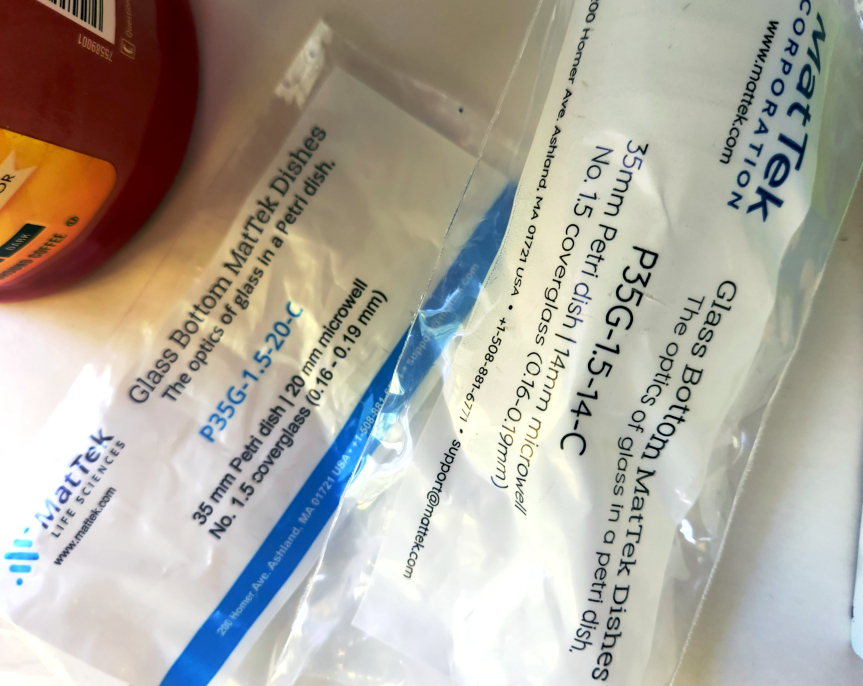Can we image organic solvent cleared tissues using an inverted confocal microscope? For instance BABB, DBE,DISCO.
The main concern is safety; what type of chamber would protect the microscope (and user)?
Another concern is image quality.
Chambers and Safety
 We have learned from experience that organic solvent based cleared tissues should not be used on a 2 photon microscope. Samples combust. Fortunately, no lenses were damaged when we tried this. We thought this might happen so we kept laser power low, but it happened.
We have learned from experience that organic solvent based cleared tissues should not be used on a 2 photon microscope. Samples combust. Fortunately, no lenses were damaged when we tried this. We thought this might happen so we kept laser power low, but it happened.
Solvents evaporate quickly. Keep chamber covered and/or work in a well ventilated space.
It doesn't look pretty, but if you are worried about spills, stuff absorbent material, e.g. Kimwipes or cut up old 100% cotton t-shirts or bed sheets, around the lenses under the stage.
But you shouldn't need this if you have good chambers. Our theory was that the plastic or glues in Ibidi, Greiner, or MatTek dishes, which we routinely use, would succumb to organic solvents. A colleague said she tested these overnight and the plastic got sticky put did not leak. We should have tested this ourselves to see if the epoxy coating was really necessary, but we didn't. We did test the epoxy coating and it is impervious.
We solved the chamber problem by using Geirner, Ibidi, or MatTek dishes additionally sealed with 5 minute epoxy (allowed to set 24 hours). We like clear 5 minute epoxy for this because at first it flows and although you have to work fast, once you get it in to position, it stops flowing fast so the center portion of the glass dish remains clean. The goal was to seal the interface of glass and plastic and to coat the plastic. We used toothpicks to paint the epoxy on the dishes.




Any brand epoxy works.
Image Quality
For aqueous cleared samples, we used to use a 20X N.A. 1.00 water immersion objective lens on a Zeiss 710 confocal microscope.
We are now use HC FLUOTAR L 16x/0.6 IMM CORR VISIR multi-immersion or HC FLUOTAR L 25x/0.95 W VISIR 0.17 water lens on a Leica Stellaris confocal.
For organic solvent cleared samples, we have a Zeiss LCI Plan-Apochromat 25x/0.8 Imm Corr DIC M27 for oil, water, silicone oil or glycerine immersion (D=0-0.17mm) (WD=0.57mm at D=0.17mm) on a Zeiss 880 confocal and are especially happy with the image quality using this lens with oil. However, a benefit of the water 20X lens for lightsheet was that it went 3 mm deep whereas this lens only goes 0.57 mm deep, so it often crashes before we are deep enough.
We have found that 20X air lenses do not work well.
And samples need to be clear. The biggest problem is users bringing in cloudy tissues and insisting they are clear enough. Clear is clear; cloudy is not clear.
To keep samples pressed against the coverslip, we put pieces of cut glass coverslips on top of the samples. The trick is to use enough weight to push the sample against the coverslip without compressing it so much that images are distorted.


<back
 We have learned from experience that organic solvent based cleared tissues should not be used on a 2 photon microscope. Samples combust. Fortunately, no lenses were damaged when we tried this. We thought this might happen so we kept laser power low, but it happened.
We have learned from experience that organic solvent based cleared tissues should not be used on a 2 photon microscope. Samples combust. Fortunately, no lenses were damaged when we tried this. We thought this might happen so we kept laser power low, but it happened. 




